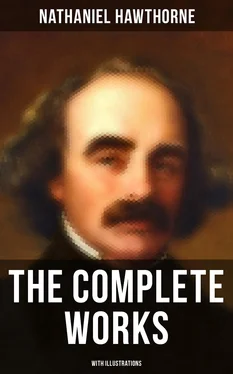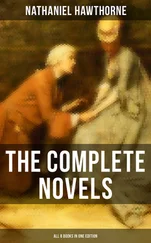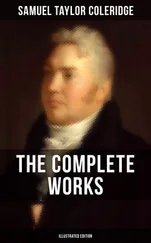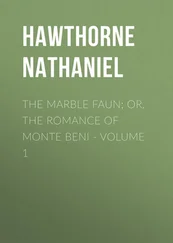Up the stairs, drawing his tattered cloak about his face, came the model, at whom Beppo looked askance, jealous of an encroacher on his rightful domain. The figure passed away, however, up the Via Sistina. In the piazza below, near the foot of the magnificent steps, stood Miriam, with her eyes bent on the ground, as if she were counting those little, square, uncomfortable paving-stones, that make it a penitential pilgrimage to walk in Rome. She kept this attitude for several minutes, and when, at last, the importunities of a beggar disturbed her from it, she seemed bewildered and pressed her hand upon her brow.
“She has been in some sad dream or other, poor thing!” said Kenyon sympathizingly; “and even now she is imprisoned there in a kind of cage, the iron bars of which are made of her own thoughts.”
“I fear she is not well,” said Hilda. “I am going down the stairs, and will join Miriam.”
“Farewell, then,” said the sculptor. “Dear Hilda, this is a perplexed and troubled world! It soothes me inexpressibly to think of you in your tower, with white doves and white thoughts for your companions, so high above us all, and With the Virgin for your household friend. You know not how far it throws its light, that lamp which you keep burning at her shrine! I passed beneath the tower last night, and the ray cheered me, because you lighted it.”
“It has for me a religious significance,” replied Hilda quietly, “and yet I am no Catholic.”
They parted, and Kenyon made haste along the Via Sistina, in the hope of overtaking the model, whose haunts and character he was anxious to investigate, for Miriam’s sake. He fancied that he saw him a long way in advance, but before he reached the Fountain of the Triton the dusky figure had vanished.
CHAPTER XIII
A SCULPTOR’S STUDIO
Table of Contents
About this period, Miriam seems to have been goaded by a weary restlessness that drove her abroad on any errand or none. She went one morning to visit Kenyon in his studio, whither he had invited her to see a new statue, on which he had staked many hopes, and which was now almost completed in the clay. Next to Hilda, the person for whom Miriam felt most affection and confidence was Kenyon; and in all the difficulties that beset her life, it was her impulse to draw near Hilda for feminine sympathy, and the sculptor for brotherly counsel.
Yet it was to little purpose that she approached the edge of the voiceless gulf between herself and them. Standing on the utmost verge of that dark chasm, she might stretch out her hand, and never clasp a hand of theirs; she might strive to call out, “Help, friends! help!” but, as with dreamers when they shout, her voice would perish inaudibly in the remoteness that seemed such a little way. This perception of an infinite, shivering solitude, amid which we cannot come close enough to human beings to be warmed by them, and where they turn to cold, chilly shapes of mist, is one of the most forlorn results of any accident, misfortune, crime, or peculiarity of character, that puts an individual ajar with the world. Very often, as in Miriam’s case, there is an insatiable instinct that demands friendship, love, and intimate communion, but is forced to pine in empty forms; a hunger of the heart, which finds only shadows to feed upon.
Kenyon’s studio was in a cross-street, or, rather, an ugly and dirty little lane, between the Corso and the Via della Ripetta; and though chill, narrow, gloomy, and bordered with tall and shabby structures, the lane was not a whit more disagreeable than nine tenths of the Roman streets. Over the door of one of the houses was a marble tablet, bearing an inscription, to the purport that the sculpture-rooms within had formerly been occupied by the illustrious artist Canova. In these precincts (which Canova’s genius was not quite of a character to render sacred, though it certainly made them interesting) the young American sculptor had now established himself.
The studio of a sculptor is generally but a rough and dreary-looking place, with a good deal the aspect, indeed, of a stone-mason’s workshop. Bare floors of brick or plank, and plastered walls, — an old chair or two, or perhaps only a block of marble (containing, however, the possibility of ideal grace within it) to sit down upon; some hastily scrawled sketches of nude figures on the whitewash of the wall. These last are probably the sculptor’s earliest glimpses of ideas that may hereafter be solidified into imperishable stone, or perhaps may remain as impalpable as a dream. Next there are a few very roughly modelled little figures in clay or plaster, exhibiting the second stage of the idea as it advances towards a marble immortality; and then is seen the exquisitely designed shape of clay, more interesting than even the final marble, as being the intimate production of the sculptor himself, moulded throughout with his loving hands, and nearest to his imagination and heart. In the plaster-cast, from this clay model, the beauty of the statue strangely disappears, to shine forth again with pure white radiance, in the precious marble of Carrara. Works in all these stages of advancement, and some with the final touch upon them, might be found in Kenyon’s studio.
Here might be witnessed the process of actually chiselling the marble, with which (as it is not quite satisfactory to think) a sculptor in these days has very little to do. In Italy, there is a class of men whose merely mechanical skill is perhaps more exquisite than was possessed by the ancient artificers, who wrought out the designs of Praxiteles; or, very possibly, by Praxiteles himself. Whatever of illusive representation can be effected in marble, they are capable of achieving, if the object be before their eyes. The sculptor has but to present these men with a plaster-cast of his design, and a sufficient block of marble, and tell them that the figure is imbedded in the stone, and must be freed from its encumbering superfluities; and, in due time, without the necessity of his touching the work with his own finger, he will see before him the statue that is to make him renowned. His creative power has wrought it with a word.
In no other art, surely, does genius find such effective instruments, and so happily relieve itself of the drudgery, of actual performance; doing wonderfully nice things by the hands of other people, when it may be suspected they could not always be done by the sculptor’s own. And how much of the admiration which our artists get for their buttons and buttonholes, their shoe-ties, their neckcloths, — and these, at our present epoch of taste, make a large share of the renown, — would be abated, if we were generally aware that the sculptor can claim no credit for such pretty performances, as immortalized in marble! They are not his work, but that of some nameless machine in human shape.
Miriam stopped an instant in an antechamber, to look at a half-finished bust, the features of which seemed to be struggling out of the stone; and, as it were, scattering and dissolving its hard substance by the glow of feeling and intelligence. As the skilful workman gave stroke after stroke of the chisel with apparent carelessness, but sure effect, it was impossible not to think that the outer marble was merely an extraneous environment; the human countenance within its embrace must have existed there since the limestone ledges of Carrara were first made. Another bust was nearly completed, though still one of Kenyon’s most trustworthy assistants was at work, giving delicate touches, shaving off an impalpable something, and leaving little heaps of marble dust to attest it.
“As these busts in the block of marble,” thought Miriam, “so does our individual fate exist in the limestone of time. We fancy that we carve it out; but its ultimate shape is prior to all our action.”
Читать дальше












